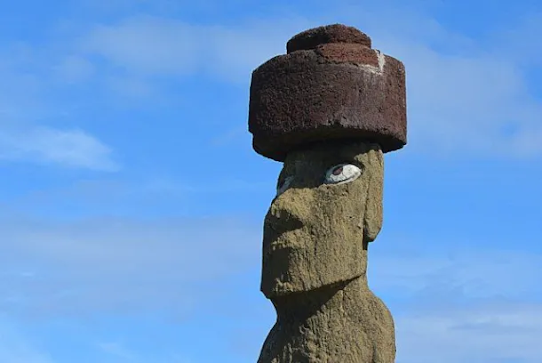After Ahu a Kivi, we went to Puna Pau, which is the quarry site for the red scoria (porous, volcanic rock) that the Rapa Nui used to make the crowns/hats/top knots that some of the moai have. The second picture shows an example of a moai with such a hat. The hats crack me up. The Rapa Nui spent years carving these gigantic moai, took all the trouble to move the moai to the desired location, and then said "you know what this thing needs? A hat! Let's make our jobs that much harder by attaching a separate object carved from a separate quarry on top of this 30 foot high statue." Funny. That sounds like a decision made by management, not by the worker. Goes to show some projects are done regardless of the extra pain and toil required.
The hats were fixed to the moai with a peg and hole design, and you can see in this picture a hat with the hole carved out. You can also get a sense for how big the hats themselves were, taller than a person! The next question is how the Rapa Nui managed to raise the hats onto the moai. You'd think they'd try to raise both the hat and the moai at the same time. But, alot of the hats date later than the moai themselves, meaning they were attached after the fact. How? With ropes? With a ramp? Another question to throw on the pile. They were understandably rolled from the quarry to the chosen ahu, but, after that, experts are unsure. There were numerous abandoned hats scattered around the outside of the quarry. What moai were they for? Why were they abandoned? Shoulder shrug.
We visited Rapa Nui in the rainy season, which is also the off season for tourists. Made everything much less crowded, which was great, but we definitely had some rainy days toward the end of the trip where we couldn't do much. Luckily, we were there for so long we had additional flexibility to pick the best weather days for things. I could see if you were trying to cram in everything into a long weekend, and it rained the whole time, it would be pretty demoralizing. Some of the sites, the main moai quarry Rano Raraku in particular, they close when it rains as it becomes dangerous to hike around with the steep, slippery rocks. The day we visited these sites, the weather was great. Another added bonus to the rainy season were the incredible number of flowers in bloom, these yellow guys in particular. The island was absolutely covered in them.
Next we visited Ahu Vinapu, which is an original intact ahu (many of the other ahus were rebuilt when the moai were reraised). The stone work on this ahu is beyond impressive. The rocks have been shaped perfectly square, and there is hardly any gap at all when the stones are joined together. Given the porous nature of this volcanic rock, achieving this level of perfection without metal tools would have required some serious stone working skills, skills that are unfortunately completely lost to the Rapa Nui today. Our tour guide, who if you'll remember is 100% Rapa Nui, actually does not believe his own people made the ahus and moai, but that, instead, another alien race inhabited the island before the Rapa Nui arrived, and they left during some cataclysmic event, leaving the ahu and moai behind for the Rapa Nui to discover. As far as conspiracy theories go, this one is pretty out there. But I found it shocking and somewhat depressing that an actual Rapa Nui had so little confidence in his own people that he couldn't believe they built all this stuff. It is true that today the Rapa Nui couldn't do it without modern tools. The ancestral knowledge has been indeed lost, and that is truly depressing. Brings forth questions about the impacts and beliefs surrounding colonization. So many colonizers believed they were "helping" the indigenous heathens, because our beliefs and customs must be the "right" way, when in reality they didn't need to be helped. The Rapa Nui clearly was a thriving, highly advanced society, and it wasn't until European explorers found them did things start going sideways. It always seems to be about taking by the colonizers. Taking resources, land, literal people. Never is it about learning, about sharing. Now, there are definitely times when things get so out of hand, help is needed. The Chileans would argue they stepped in and made Rapa Nui a territory because the situation was dire, and the people needed support. Today's missionaries in various places would probably so argue the same. We're digging wells and providing modern medicine to remote places. And that's true. But they're fixing problems that are the result of hundreds of years of abuse. The damage is done though, I suppose. Let's just do the next right thing and hopefully learn a few lessons from history.










No comments:
Post a Comment